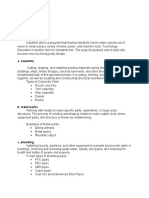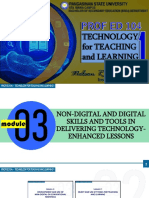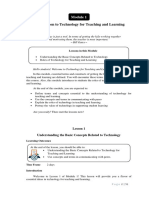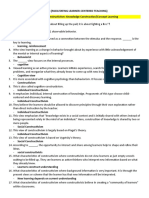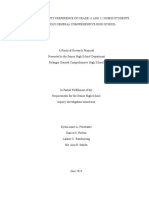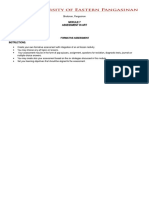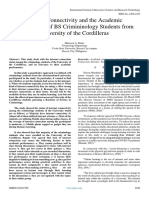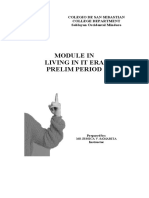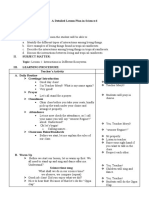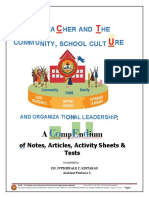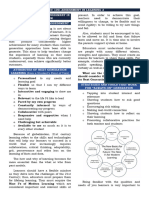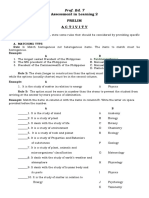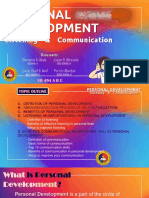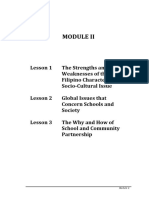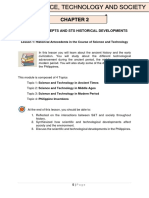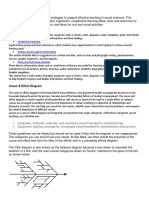0 ratings0% found this document useful (0 votes)
110 views13 pagesModule 1
21st Century Education
Uploaded by
hanna grace miagaCopyright
© © All Rights Reserved
We take content rights seriously. If you suspect this is your content, claim it here.
Available Formats
Download as PDF or read online on Scribd
0 ratings0% found this document useful (0 votes)
110 views13 pagesModule 1
21st Century Education
Uploaded by
hanna grace miagaCopyright
© © All Rights Reserved
We take content rights seriously. If you suspect this is your content, claim it here.
Available Formats
Download as PDF or read online on Scribd
You are on page 1/ 13
Module 1: 21% Century Education
Module 1:
218' CENTURY EDUCATION
pe
© LEARNING OUTCOMES
. Define 21* Century education
. Describe the 21" Century teacher and the
;. Draw relevant life lessons and significant
. Prepare an evaluation instrument intended
needed innovative tools for learning
Examine the critical attributes of 21%
Century education
Explain how 21" Century education
concepts can be integrated in the classroom
values from the experience in practicing 21" |
Century education
Analyze research abstract on 21% Century
education and its implications on teaching-
learning process
for 21% Century teaching-learning
ee INTERACTIVE PRESENTATION
The Carousel Round: In this strategy, students will generate
information through: personal ideas, thoughts and insights on 21*
Century education. This is also to determine their prior knowledge
on the given topic.
Procedure:
Students will form two big circles in class: the inner core and
outer core. “
The inner core will rotate clockwise while the outer core
counterclockwise upon the signal of the teacher. When the
teacher keeps on uttering “carousel...carousel...carousel”,
students will also keep on rotating. When he/she says “Off’,
students will stop and face partners.
The teacher will then ask questions and students share their
answers with their partners in a given time.
Sample Questions:
A. What is your understanding of 21% Century learning?
B. What digital tool do you know? And how is it operated?
C. What can you say about 21" Century learners?
D. How do you describe technology?
E. Are you in favor of this technological world?
1
M
Burton ano ENHANcine New Literacies Across THe CurRicuLu
4. This will continue until the teacher has asked all the ques;
at hand. ‘ .
5. The class will provide enough time for reflection on the acti
Guide questions for reflection:
A. What questions were the most difficult and easy for you
answer? Why?
B. What answer from a partner impressed and amazed y,
Why?
C. What information have you gained from a Partner j
sharing his/her mind?
D. What have you shared with a Partner regarding your vie
about 21% Century learning?
—. What can you say about the activity? What can you
Suggest for further improvement of the next activity?
ris CONCEPT EXPLORATION
This modern society is ushered in by a dramatic technological
revolution. It is an increasingly diverse, globalized and complex media-
Salurated society. According to Dr. Douglas Kellner, this technological
revolution bears a greater impact on society than the transition from an
oral to print culture.
Education prepares students for life in this world. Amidst emerging
Social issues and concerns, there is a need for students to be able
to communicate, function and create change personally, socially,
economically and politically at the local, national and global levels by
Participating in real-life and real-world service learning projects.
Emerging technologies and resulting globalization also provide
unlimited possibilities for exciting discoveries and developments.
24" Century Education Contexts
21* Century Schools. Schools in the 21% century focus on
@ project-based curriculum for life that would engage students in
addressing real-world Problems and humanity concerns and issues.
This has become an innovation in education, from textbook-
driven, teacher-centered, Paper-and-pencil schooling into a better
understanding of the Concept of knowledge and a new definition of
the educated person, Therefore, it makes a new way of designing and
delivering the curriculum.
a
Module 1; 21" Century Educa
Schools will go from ‘buildings’ to ‘nerve centers’, with open
walls and are roofless while connecting teachers, students and the
community to the breadth of knowledge in the world.
Teachers will transform their role from being dispensers of
information to becoming facilitators of learning and help students
translate information into knowledge and knowledge into wisdom.
Therefore, the 21" century will require knowledge generation, not
just information delivery, and schools will need to create a “culture of
inquiry”.
Learners will become adaptive to changes. In the past, learners
spent a required amount of time in respective courses, received
passing grades and graduated. Today, learners are viewed in a new
context.
These changes have implications for teachers: (1) Teachers must
discover student interest by helping them see what and how they
are learning to prepare them for life in the real world; (2) They must
instill curiosity, which is fundamental to lifelong learning; (3) They must
be flexible in how they teach; and (4) They must excite learners to
become more resourceful so that they will continue to learn outside
formal school.
21 Century learning demands a school that excites students for
school, There is a little or no discipline. problem because of strong
student engagement. Likewise, parents are informed about positive
changes in their children. As a result, students manifest significant
imptovement in basic skills of reading, writing, speaking, listening,
researching, scientific explorations, math, multimedia skills and others.
The 21" Century Curriculum. The twenty-first century curriculum,
has critical attributes that are interdisciplinary, project-based
and research-driven. It is connected to local, national and global
communities, in which students may collaborate with people around
the world in various projects. The curriculum also integrates higher-
order thinking skills, multiple intelligences, technology and multimedia,
multiple literacies and authentic assessments, including service-
learning (http:/edglossary.org/21s'-century-skills).
The classroom is filled with self-directed students, who work
independently and interdependently, The curriculum and instruction
are designed imbued with the concept of differentiation. Thus, instead
of focusing on textbook-driven or fragmented instruction, instruction
turns to be more thematic, project-based and integrated with skills and
competencies purely not confined within themselves, but are explored
through research and concept application in projects and outputs
(http://edglossary.org/21-century-skills).
SUILDING AND ENHANCING New LITERAGIES ACROSS THE CURRICULUM
Learning is not confined through mT onan ed
figures alone but rather is connected to previous
experience, interests, talents and habits. ’ ‘
ironment. Typically, a 218
The 21% Century Learning Envir ye
Century classroom is not confined to a literal a oor a
a learning environment where students collabora’ eT ee ee
exchange insights, coach and mentor one another al ie eee
and skills with other students. Cooperative learning is rot i
in which students work in teams because cooperation a ma te
emphasis than competition, and collaborative learning i ; lan
isolated learning. They use technologies, including Internet systems
and other platforms. :
Hence, in the process of creating a world-class 21" century
and remodeling of present
learning environment, building new schools ¢
school facilities can be addressed toward creating environmentally
friendly, energy-efficient, and “green” schools. Inside every classroom,
students shall apply their knowledge of research in life, which is a
clear indication of a relevant, rigorous, 21*century real-life curriculum.
An ideal learning environment also considers the kind of spaces
needed by students and teachers in conducting investigations and
projects by diverse groups for independent work. An ideal learning
environment has plenty of wall space and other areas for displaying
student work that includes a place where the parents and the
community can gather to watch student performances, as well as a
place where they can meet for discussions.
Technology in the 21% Century Pedagogy. Technologies are
not ends in themselves but these are tools students use to create
knowledge for personal and social change. .
| 24" Century learning recognizes full access
Therefore, a better bandwidth of Wifi access soa be
along areas of the school for the students to access their files and
supplement their learning inside the classroom. Various laboratories
and learning centers are set up in such a way that they allow a
space needed for students’ simulation and manipulative works, All
classrooms should have televisions to watch broadcasts cate b:
the school and other schools around. Other resources in the sch 4
en also be utilized by students in creating opportunities for thelr
eeesee explorations (http://www.21stcenturyschools.com/Critical _ Pedagogy.
Understanding 21* Century Learners. Today's students are
referred to as “digital natives”, while educators “digit
2 as “digital 3]
(Prensky, 2001). Most likely, digital natives usually eee ae
Module 1: 21% Century Educatic
holistic and non-linear. Their predominant senses are motion and
touch. They learn through experience and learn differently. Digital
immigrants often reflect, are sequential, and linear. Their predominant
senses are hearing and seeing. They tend to intellectualize and
believe that learning is constant (Hawkins and Graham, 1994),
Students’ entire lives have been immersed in the 21" Century
media culture. They take in the world via the filter of computing
devices, such as cellular phones, hand held gaming devices, PDAs,
and laptops plus the computers, TVs, and game console at home.
A survey by the Henry J. Kaiser Family Foundation found that
young people (ages 8-18) spend on electronic media an average of
six hours a day. In addition, many are multitasking, such as listening to
music while surfing the Web or instant-messaging friends while playing
a video game.
The preschoolers easily navigate electronic multimedia resources
on games, in which they learn colors, numbers, letters, spelling, and
more complex tasks, such as mixing basic colors to create new colors,
problem-solving activities, and reading.
However, as Dr. Michael Wesch points out, although today's
students understand how to access and utilize these tools, they use
them only for entertainment purposes. Thus, students should be
prepared and assisted to become media literate as they function in
| ani online collaborative research-based environment with the advent of
researching, analyzing, synthesizing, critiquing, evaluating and creating
new knowledge.
21" Century Skills Outcome and the Demands in the Job
Market. The 21% Century skills are a set of abilities that students
need to develop to succeed in the information age. The Partnership
for 21% Century Skills lists three types, namely: (1) Learning Skills
| which comprise ‘critical thinking, creative thinking, collaborating, and
communicating; (2) Literacy Skills which is composed of information
literacy, media literacy, and technology literacy; and (3) Life Skills that
include flexibility, initiative, social skills, productivity and leadership.
| These skills have always been important in an information-based
economy.
|
| Likewise, skills demanded in the job market include knowing a
| trade, following directions, getting along with others, working hard
| and being professional, efficient, prompt, honest, and fair. More
so, to adapt to these jobs in this information age, students need to
think deeply about issues, solve problems creatively, work in teams,
communicate clearly in many media, learn ever-changing technologies
and deal with the influx of information. Amidst rapid changes in the
jexible, take the initiative, lead
: fl
World, industry requires students to be Neo fe
i net
when necessary, and create something
ing to Partnership for 21% Century on fae ee
eee mployees who can tink eically, ® Probleme
sie et ie ie collaborate and communicate. pts for a
creatively, innovate, academe and industry demands, sc} ols need
perfect match Fee ea alstry-demanded work eve in the Curriculum
ft ‘i Oy fesning com/resources/what-are-21"-century-skills).
(http:
i lications. 21" Century skills are
* Century Learning Imp! 1 r
J Deine beanie areas and the skills may be taught in
a variety of both in-campus and community settings.
Teachers should practice teaching cross-disciplinary skills in
related courses, such as integrating research methods in various
disciplines; articulating technical scientific concepts in verbal,
written, and graphic forms; presenting laboratory reports to a pool
of specialists, or use emerging technologies, software programs and
multimedia applications as an extension of an assigned project.
Likewise, accrediting organizations and regulatory bodies may
require 21° century skills in the curriculum. In doing so, the assessment
tools should also contain these skills, They may design or adopt
learning standards that explicitly describe multi-disciplinary skills that
students should acquire and master.
Schools and teachers should
multiple technologies, and new
information, while also taking initi
the process, and working collabo
use a variety of applied skills,
ways of analyzing and processing
ative, thinking creatively, planning out
ratively in teams with other students.
More so, schools may allow stu
in which
In today’s worlg
‘ |, information and knowl
increasing at a certain rat wledge are continuously
i fe that no one can learn everything about
ay appear true today could be roven to be
false tomorrow and the jobs that th
stud:
may not yet exist Fev ‘udents will get after they graduate
this reason, Students need to be tau
fi ight how to
Sera analyze and tion and they need adaptable
skills that they can apply in all facets
f life. Thus, merel teachi)
them ideas and facts without teachi hi ; 4 a
i; :
life settings is no longer enough, peau ey) tis pe eae
Module 1; 21" Century Education 7
Schools need to adapt and develop new ways of teaching and
learning that reflect a changing world. The purpose of school should
be to prepare students for success after graduation and therefore,
schools need to prioritize the knowledge and skills that will be in
the greatest demand, such as those deemed to be most important
by college professors and employers. Hence,” teaching students to
perform well in school or pass the test alone is no longer sufficient.
Henceforth, teachers must realize and students must understand
that no one can move toward a vision of the future unless he/she
understands the socio-historical context of where they are now,
what events led them to be where they are, how this can inform
development of a vision for the future and how they want to get there.
Thus, a clear articulation of the purpose of education for the 21st
Century is the place to begin. (http:/thoughtfullearning.com/resources/
what-are-21st-century-skills)
A Paradigm Shift for 21° Century Education
Before 21" Century Education
21" Century Education
Time-based
Outcome-based
Focus: memorization of discrete facts
Focus: what students Know, Can Do
and Are Like after all the details are
forgotten.
Lowerorder thinking skills in Bloom's Taxonomy,
such as knowledge and comprehension
Higher order thinking skills (metacog-
nition); such as application, analysis,
synthesis, and evaluation
Textbook-driven
Research-driven
Passive learning
Active learning
Learners work in isolation and confined in, the
classroom (walled classroom) .
Teacher-centered: teacher is dispenser of
knowledge, information and attention.
~ | student-centered: teacher is facilitator
Learners work collaboratively with
classmates and others around the world
(global classroom).
coach of students’ learning.
Lite
SSO slicont epson
IScij
and ae Problems" — No trust between educators
nts, Little student motivation,
Fragmented Curriculum
Grades take
N from formal
entered in assessment measures
the class record for feporting purposes
Assessment is for marking purposes and placed as
Part of lesson plan structure
Low expectations. What students receive is what.
| they get.
Teacher is judge. No one else sees ‘student work.
Outputs are assessed using structured metrics,
Curriculum is irrelevant and meaningless to the
students.
Print is the primary vehicle of leariing and
assessment.
Student diversity is ignored
2 SMNANGING New Literacies Across THE CURRICULUM
_| Great deal of student freedom.
assessment.
|
No “discipline problems" - Students
and teachers have mutual respect and
relationship as co-learners. High student
motivation,
Integrated and Interdisciplinary cu
Grades are based on students’ perfor-
mance as evidence of learning outcome
Assessment is important aspect of
instruction to gauge learning outcome
High expectations that students s
learning to high extent.
Self, peer and others serve as evaluato
of student learning using wide range of
metrics and authentic assessments,
Curriculum is connected to students’
interests, experiences, talents and the rec
world.
Performances, projects and multiple
forms of media are used for learning and
Curriculum and instruction address student
diversity.
Students just follow orders and instructions while
listening to teacher's lecture.
Literacy is the 3 R's (reading, writing and
‘rithmetic)
problems.
Students are empowered to lead and
initiate while creating solutions and solving
‘4
Multiple literacies of the 21* Century
aligned to living and working in a
globalized new society.
Factory model, based upon the needs of employers
for the Industrial Age of the 19" century
Global modet based upon the needs of a
globalized high-tech society
(Source: http:/www.21"CenturySchools.com)
The paradigm shift from the 20" to the 21% Century, shows that the
structure and modalities of education have evolved. Students become the
center of teaching-learning process in the 21% Century using wide array of
technological tools to assist them in exploring knowledge and _ information
needed in surviving the test of time and preparing for future career endeavors.
Assessment has been made varied to address multiple literacy development
in diverse contexts. Teachers turn to become facilitators rather than lecturers
Mend dispensers of information. As such, curriculum is designed in a way that
reshapes the students’ holistic perspectives.
a -
it connects to life in the real world, interconnected with other disciplines and
:
The Critical Att
Education,
ributes of 274s Century
Education continuously “ changes
ime. There is
The following are eight attributes
of 21* Century education’
implications: j ye ion and their
1. Integrated and Interdisciplinary. Education in the 24%
Century is characterized by interfacing various disciplines
im an integrated manner rather th;
an_compartmentalizing its
Subsequent parts. This critical attr
ribute implies the need to
review the curriculum and create Strategies infusing different
subjects toward enhancing the learning experiences of
students.
Technologies and Multimedia. Education in. the 215
Century makes optimum use of available Information and
Communication Technology (ICT), as well as multimedia to
improve the teaching and learning process, including online
applications and technology platforms. It implies a need to
acquire and use computers and multimedia equipment and the
design of a technology plan to enhance learning at its best.
3. Global Classrooms. Education in the 21% Century aims fo
produce global citizens by exposing students to the issues and
concerns in the local, nationat and global societies. This critical .
attribute implies the need to include current global issues/ ;
concerns, such as peace and respect for cultural diversity,
climate change and global warming in classroom discussions.
4. Creating/Adapting to Constant Personal and Social
Change and Lifelong Learning. Education in the 21* Century
subscribes to the belief that learning does not end within
the four walls of the classroom.: Instead, it can 'take place
anywhere, anytime regardless of age. This means that teachers
should facilitate students’ learning even beyond academics.
Therefore, it should not end with. requirement compliance
and passing the exams, but also for transferring and applying |
knowledge to a new context or real-life situations. As such, the
curriculum should be planned in such a way that. students will
Literacies ACROSS rue CURRICULUM :
ide the schoo! for life.
i ’
0 Butoine ano EnHancinc New
to learn even outs!
continue :
5, Student-Centered. Education in the 2p CoE ans fous
on students as learners while addressing their needs.
in the 218° Century
‘ 5s ion iS relevant ii
Differeritiated instructi ity factors and issues are taken
classrooms, where diversi + tak
into account and addressed when planning and delivering
instruction, including their learning styles, interests, needs and
abilities.
in the 21 Century
- Is. Education
2a Century Skill in becoming productive
Kills needed
demonstrates the & ing the basic skills of reading,
0 develop life and
members of society:
,, students should als !
ich as critical and
writing and numeracy, :
work skills in 21% Century communities, su i
creative thinking, problem-solving and decision-making and ICT
lies that teachers should —
literacy and skills. Therefore, it impli
possess these skills first before their students.
d Research-Driven. 21% Century education
ce-based decision-
emphasizes data, information and eviden' D
making through student activities that encourage active
learning. This implies the need for knowledge and skills in
research, such as self-directed activities, learning projects,
investigatory projects, capstones and other research-based
output.
7. Project-Based an
rid. Education in the 21%)
to real-life experiences of
information
.s and Real Wo.
8. Relevant, Rigorou:
| as it connects
Century is meaningful
learners. It implies the use of current and relevant
linked to real-life situations and contexts.
(http:/iflex.innotech. org/GURO21/module1/11_S.html)
The Characteristics of a 21" Ceniury Teacher
The 21% Century teaching-learning environment becomes more
complicated brought by technological changes. Therefore, teachers
should be able to cope with and adapt to these changes.
pe teachers must be equipped with attributes, knowledge
ane Bese cing 21% century education so that they may be
al integrate them in their t i a
See ca sx ir teaching. 21° Century teachers are
1. Multi-literate. Teachers know how to use various
pr echnologies
in teaching. : i : ™
2. Multi-s jalis
ae eal Teachers are not only knowledgeable in the
», Subject they teach but also in other areas so that they
Module 1: 21* Century Education 11
can help the learner build up what they gain in the classroom
and outside the school and make sense of what was learned.
. Multi-skilled. Teachers cope with the demand ‘for widening
learning opportunities by being skillful not just in teaching but
also in facilitating and organizing groups and activities.
4. Self-directed. Teachers are responsible for various aspects
of school life and know how to initiate action to realize the
learning goals of the students and the educational goals of the
country, at large.
Lifelong learner. Teachers embrace the ideal that learning
never ends. Therefore, teachers must be constantly updated
on the latest information related to their subject and pedagogic
trends. They should also share what they are learning with their
students and colleagues with a high sense of professionalism.
2
gr
Flexible. Teachers are able to adapt to various learning styles
and needs of the learners. They can facilitate learner-centered
teaching with flexibility using alternative modes of delivery.
DF
Creative problem solver. Teachers create innovative ideas and
effective solutions to the arising problems in the field, be it in
the classroom, in the school or the profession as a whole.
You might also like
- A Review of Technological Tools in Teaching and Learning Computer ScienceNo ratings yetA Review of Technological Tools in Teaching and Learning Computer Science17 pages
- M5L3 Technology Enhanced Learning Lesson Plans EDUC 103No ratings yetM5L3 Technology Enhanced Learning Lesson Plans EDUC 10310 pages
- Constructivism & Learning Transfer GuideNo ratings yetConstructivism & Learning Transfer Guide9 pages
- What New Information Did I Learn From This Activity? DiscussNo ratings yetWhat New Information Did I Learn From This Activity? Discuss2 pages
- MODULE 11 Gagne's Conditions of LearningNo ratings yetMODULE 11 Gagne's Conditions of Learning16 pages
- Internet Connectivity and The Academic Performance of BS Crimininology Students From University of The CordillerasNo ratings yetInternet Connectivity and The Academic Performance of BS Crimininology Students From University of The Cordilleras10 pages
- Detailed Lesson Plan in English Ii (Traditional Format)100% (1)Detailed Lesson Plan in English Ii (Traditional Format)11 pages
- Intro to Analytical Chemistry: StatisticsNo ratings yetIntro to Analytical Chemistry: Statistics7 pages
- TECHNOLOGY FOR TEACHING AND LEARNING 1.pptx Theories in TeachingNo ratings yetTECHNOLOGY FOR TEACHING AND LEARNING 1.pptx Theories in Teaching38 pages
- Ed 228 Lesson 7 The Teacher and The CommunityNo ratings yetEd 228 Lesson 7 The Teacher and The Community6 pages
- Continuing Professional Development: The Lifeblood of The Teaching ProfessionNo ratings yetContinuing Professional Development: The Lifeblood of The Teaching Profession25 pages
- Module 6: Eco-Literacy: Intended Learning OutcomesNo ratings yetModule 6: Eco-Literacy: Intended Learning Outcomes8 pages
- Ed 404-Listening&communication-Abalo-Abrasado-Amil-AbendanNo ratings yetEd 404-Listening&communication-Abalo-Abrasado-Amil-Abendan40 pages
- Learning Modules In: Surigao Del Norte State UniversityNo ratings yetLearning Modules In: Surigao Del Norte State University34 pages
- 21st CENTURY LITERACY SKILLS Digital Literacy Skilkls (1) - CompressedNo ratings yet21st CENTURY LITERACY SKILLS Digital Literacy Skilkls (1) - Compressed28 pages
- The Philippine Government S & T Agenda: Lesson 3: Science and Technology, and Nation BuildingNo ratings yetThe Philippine Government S & T Agenda: Lesson 3: Science and Technology, and Nation Building5 pages
- Activity 1: Sink The Boat: in Water With A Paper Boat in WaterNo ratings yetActivity 1: Sink The Boat: in Water With A Paper Boat in Water3 pages
- Teaching Strategies: Graphic OrganizersNo ratings yetTeaching Strategies: Graphic Organizers12 pages
- Building and Enhancing New Literacies Across The CurriculumNo ratings yetBuilding and Enhancing New Literacies Across The Curriculum10 pages

